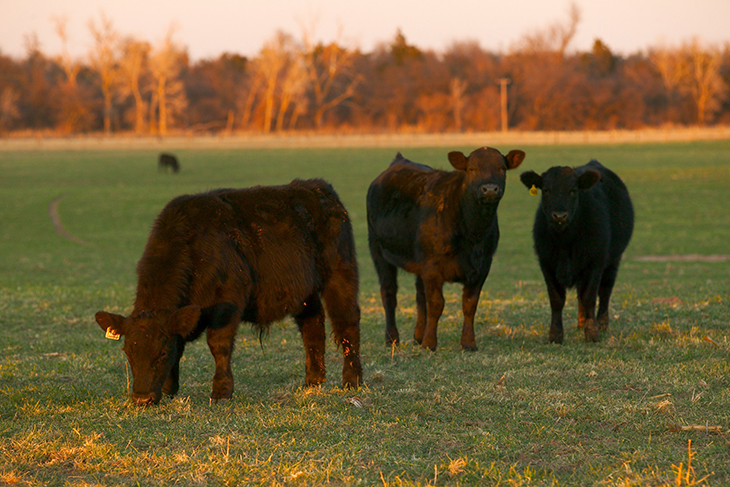
Winter wheat grazing may be profitable enterprise for some Oklahoma stocker operators
Friday, September 7, 2018
Conditions are generally favorable for early wheat planting this year in Oklahoma, and that is good news for many stocker cattle operations that depend on wheat pasture.
“Wheat planted before the end of September can be ready for grazing by Nov. 1, allow for 120 days of winter grazing by early March and still allow for the harvesting of wheat grain as a dual-purpose crop,” said Derrell Peel, Oklahoma State University Cooperative Extension livestock marketing specialist.
Oklahoma producers interested in dual-purpose or forage-only wheat for winter grazing often prefer to plant winter wheat around mid-September if conditions permit. For grain-only enterprises, winter wheat is typically planted mid to late October.
Peel said the purchase of stocker cattle for winter grazing should occur during next five to seven weeks. Timing of purchases will depend on the expected availability of wheat pasture and the ability to receive and utilize other feed resources until the wheat pasture is ready.
“In terms of winter grazing, producers may be looking to buy stockers weighing from 450 pounds to 600 pounds depending on a variety of factors; however, steers weighing about 475 pounds are the norm, all things being equal” he said.
The availability of wheat pasture often coincides with seasonal low purchase prices for stockers. Typically, prices for stockers will decrease through September to seasonal lows in October. For example, 475-pound, medium and large, number one steers in Oklahoma averaged about $170 per hundredweight in August.
“Analysts expect them to drop seasonally about 4.5 percent to October, suggesting a price of approximately $162 to $163 per hundredweight,” Peel said. “Heavier stockers weighing more than 550 pounds may drop 5 percent to 5.5 percent from August to October.”
Feeder futures provide another means to estimate purchase price in October. Peel said October Feeder futures are currently around $149 per hundredweight, showing little seasonal decline from August and September.
“Given the normal basis, the current October Feeder futures price would suggest an October cash price of $174 per hundredweight for 475-pound steers,” Peel said. “However, the basis has been weaker than usual recently for lightweight feeder cattle, suggesting October prices for 475-pound steers will be lower than $174 per hundredweight.”
In short, the cash seasonal and futures price projections suggest the price of 475-pound steers in Oklahoma is likely to average $163 to $168 per hundredweight for an October low.
“Exceptionally good wheat pasture demand could hold prices at the upper end of the range or higher while any delays in wheat pasture development could allow prices to drop to the low end of the range or below,” Peel said.
As always, profitability of winter stockers will depend on numerous budget factors, including purchase price, length of grazing period, rate of stocker weight gain, wheat pasture cost and an animal’s sale price in late February or early March. As of this writing, the current March Feeder futures contract price is $145 to $146 per hundredweight.
“This implies an Oklahoma price for 750-pound steers in early March of $146 to $148 hundredweight given an expected basis of roughly $1.50 per hundredweight,” Peel said. “Budget assumptions can vary widely but this appears to be a price that more than covers breakeven cost of production for winter grazing.”
Peel stresses producers need to develop and evaluate budgets that reflect their specific situation.
“It really is all about a producer’s specific operation,” he said. “Hopefully, current futures prices offer an opportunity to protect a decent margin for winter grazing programs.”
Oklahoma is the nation’s fifth-leading producer of cattle and calves, according to USDA National Agricultural Statistics Service data.
The Oklahoma Cooperative Extension Service is one of two state agencies administered by OSU’s Division of Agricultural Sciences and Natural Resources, and is a key part of the university’s state and federally mandated teaching, research and Extension land-grant mission.
